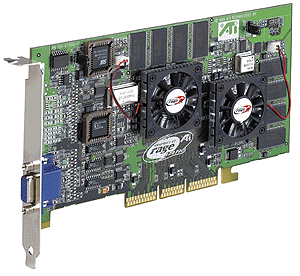
|
Less than top notch performance in the 3D gaming arena is what caused many gaming enthusiasts to shy away from ATi. Though ATi had the potential for becoming the 3D market leader, delays plagued the path of the Rage 128 chip on the way to market shelves. And in this industry, time is as valuable as money. So rather than being recognized as a leader in the graphics industry, OEM sales for low priced PC's and laptop's were their bread and butter.
70% Rating: 
|
|
|
|
Home >
Reviews >
Video Cards >
ATI Rage Fury MAXX |
|
|
ATi Rage Fury MAXX Videocard
Review
Less than top notch performance in the 3D gaming arena is what caused many
gaming enthusiasts to shy away from ATi. Though ATi had the potential for
becoming the 3D market leader, delays plagued the path of the Rage 128 chip on
the way to market shelves. And in this industry, time is as valuable as money.
So rather than being recognized as a leader in the graphics industry, OEM sales
for low priced PC's and laptop's were their bread and butter. Sure, ATi did delve
into the 3D realm with their Rage line of chips, but never were they considered
to be amongst the then current performance leaders.
ATi was determined to make a big entry into the market by
building upon an idea conceived by 3dfx with their Voodoo2 line. Somewhat
analogous to a dual CPU machine, SLI took graphical horsepower one large step
forward. Quite clever actually. While a next generation product is still in
development, why not use the best that is currently available in parallel? ATi
asked the same question. The result? The ATi Rage Fury MAXX.
Originally dubbed "Aurora", this project was
aimed at making gamers take a bit more serious look at ATi and their offerings.
Armed with dual Rage 128 Pro chips and a mammoth 32MB x 2 texture space, ATi
finally left their footprints in the high end 3D main stage.
What we will
take a look at now, is how this product fares against other graphic accelerators
on the market. Here we continue with some of the features of this
product...
ATi Rage Fury MAXX
Specifications
- 64MB 7ns
Hyundai SDRAM (32MB dedicated for each processor)
- Dual ATi Rage 128 Pro
chips
- 500 Mpixels/sec maximum fill rate
- Alternate Frame Rendering
Technology (AFR)
- Hardware DVD support
- Support for 2k x 2k
textures
- Maximum resolution of 1600x1200
- Hardware texture
compression
- AGP 4x / 2x slot compatible (does not support AGP 4x
transfers)
- Drivers for Windows 98

64MB? Wow!
Impressive
as it sounds, the 64MB of the Rage Fury MAXX is evenly divided between the
2 Rage 128 Pro chips. As each chip is responsible for handling an entire frame
on its own, each chip solely claims right to a 32MB texture cache.
So basically, the maximum practical amount of memory that exists per rendered frame is
32MB.
This of course, should not be a
disappointment to anyone as games seldom utilize such a large amount of texture
space. The good news is that both chips can share the amount of space reserved
for a framebuffer. Naturally, this would be the ideal solution in order to make
use of double and triple buffering.
|

